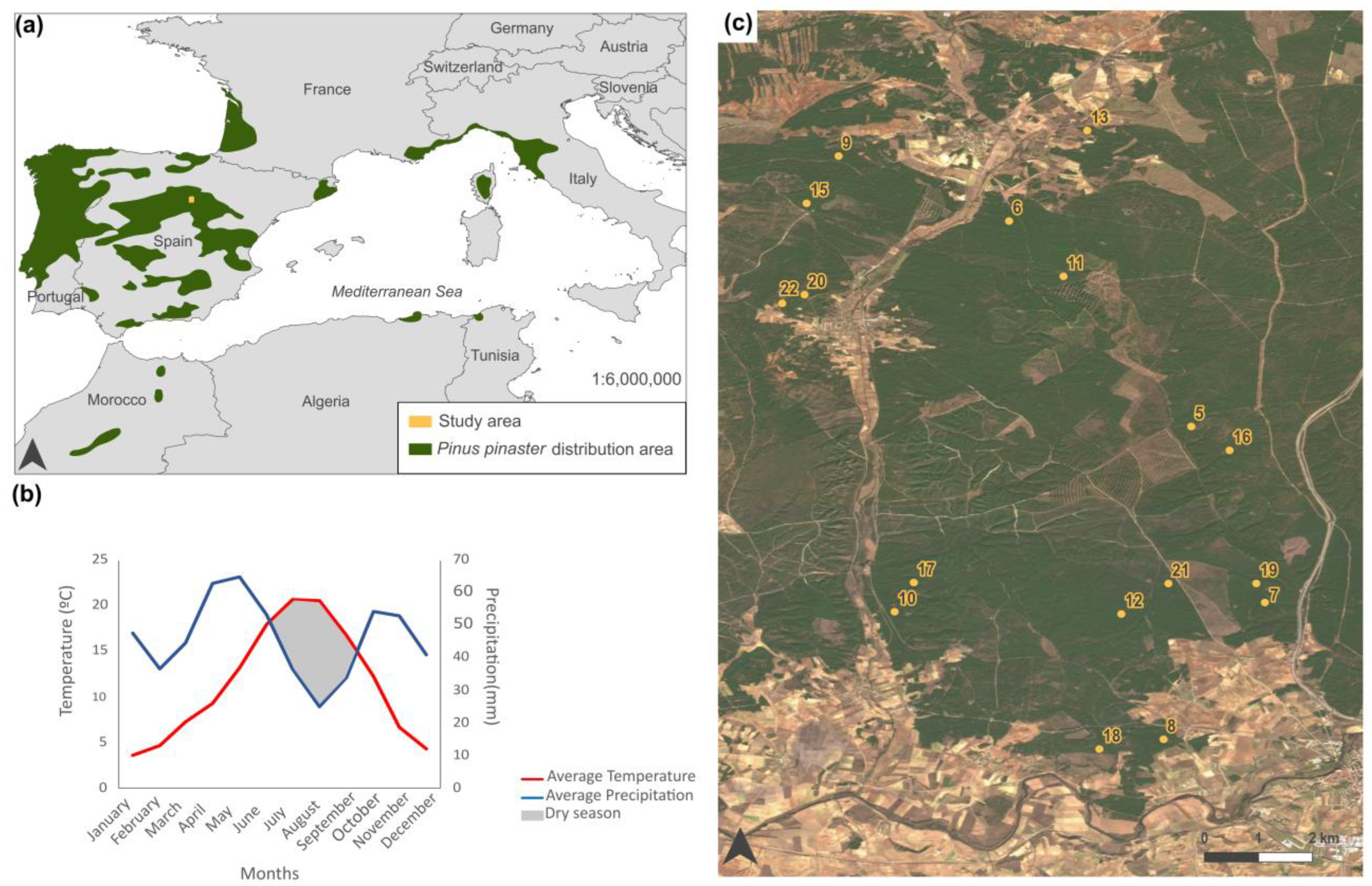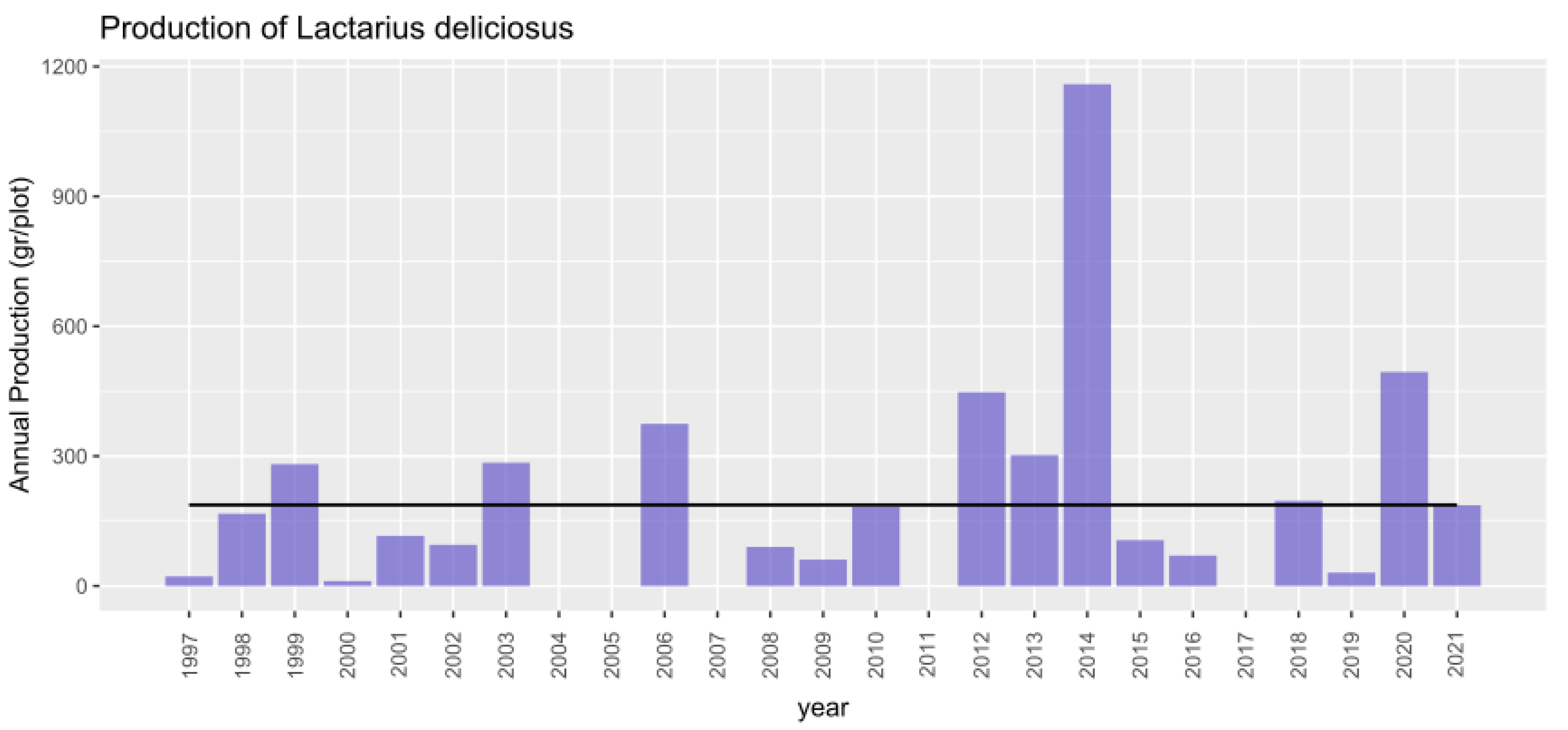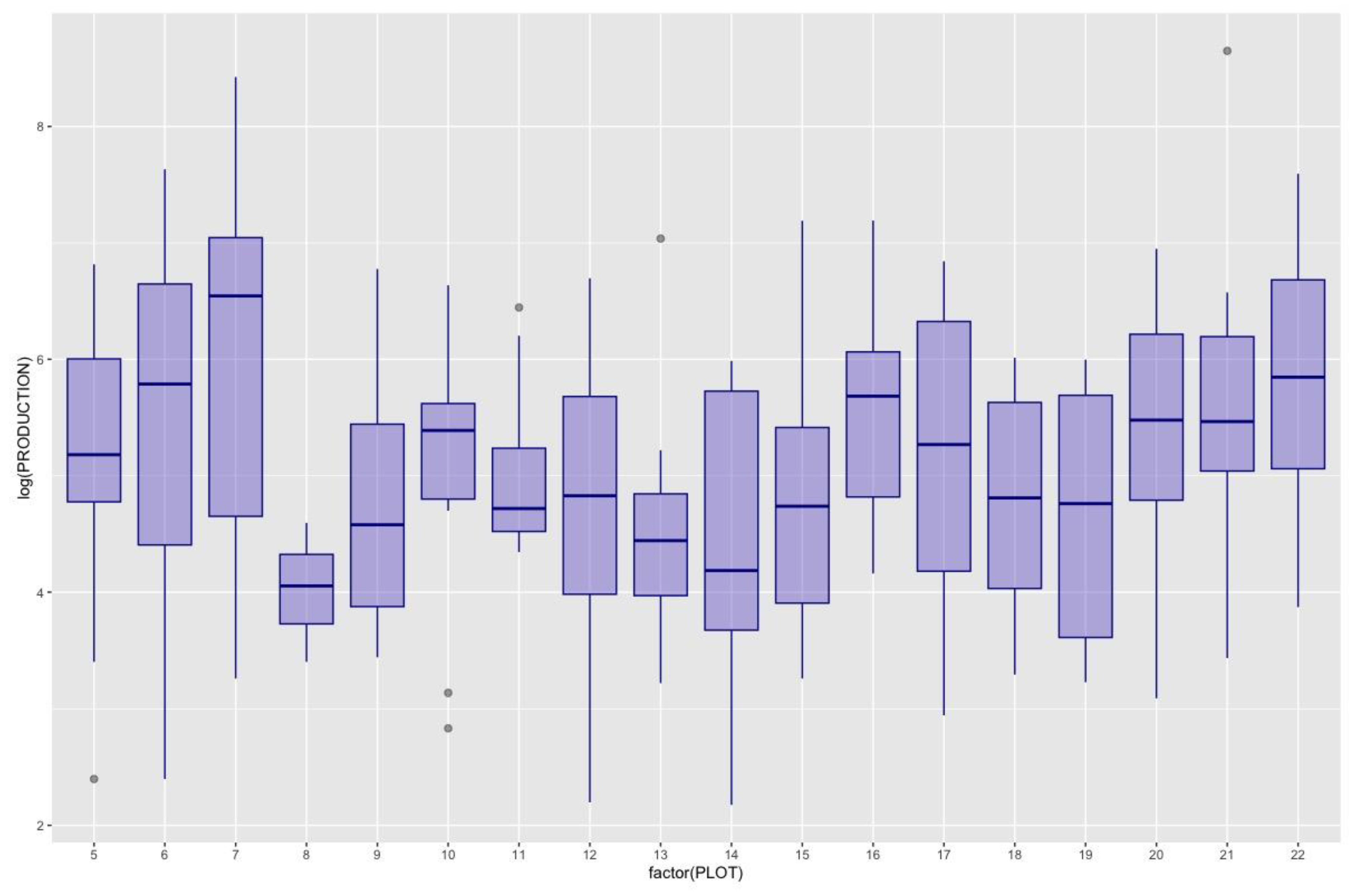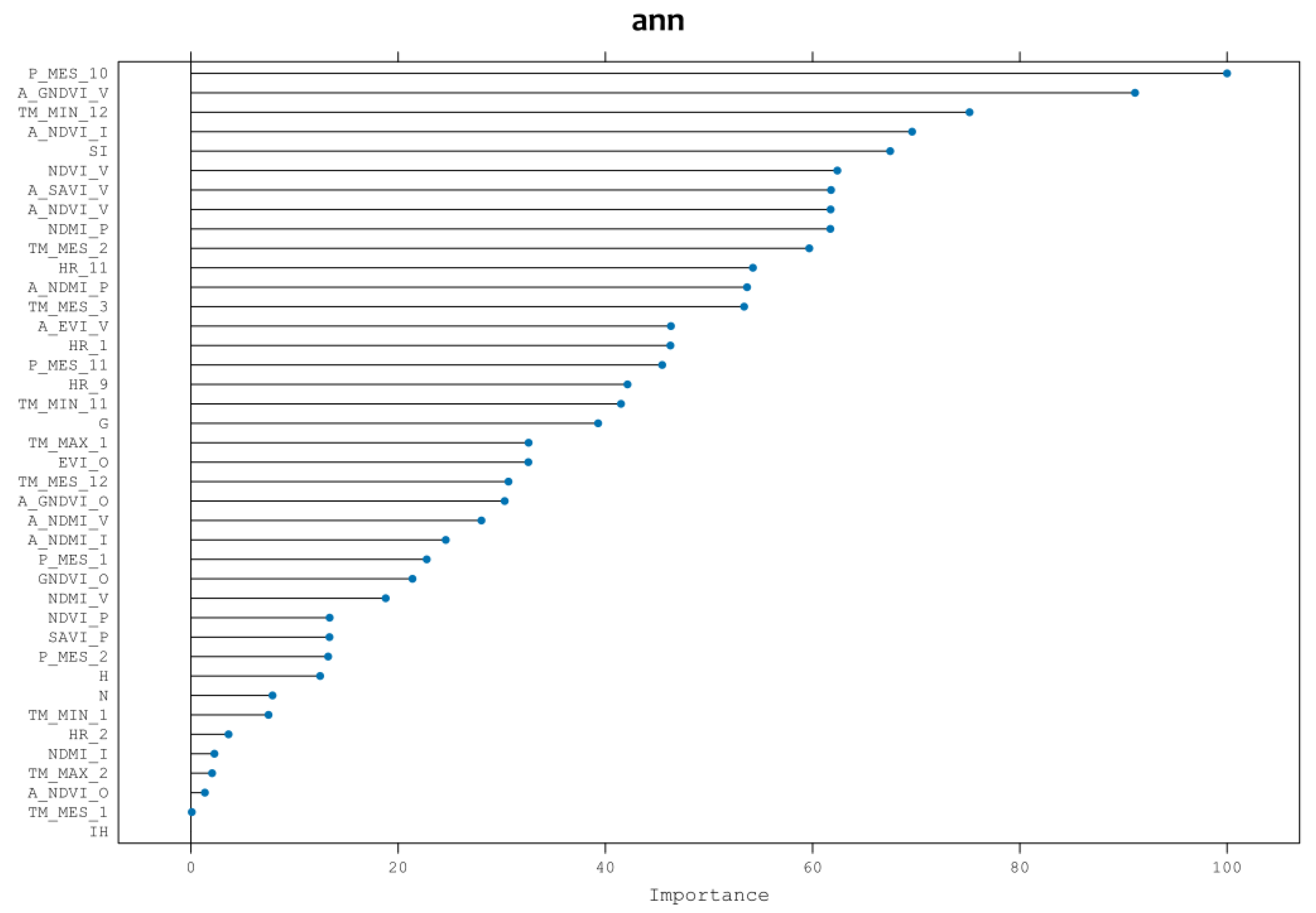Assessment of Mycological Possibility Using Machine Learning Models for Effective Inclusion in Sustainable Forest Management
Abstract
:1. Introduction
2. Materials and Methods
2.1. Study Area and Experimental Device
2.2. Mushroom Yield Data
2.3. Climatic Data
2.4. Landsat Data
2.5. Forest Structural Measurements
2.6. Statistical Analysis
3. Results
3.1. Selected predictors
3.2. First Step: Classifying Presence and Absence of Lactarius deliciosus Sporocarps
3.3. Second Step: Quantifying Lactarius deliciosus Sporocarp Production by Weight
4. Discussion
5. Conclusions
Author Contributions
Funding
Institutional Review Board Statement
Informed Consent Statement
Data Availability Statement
Acknowledgments
Conflicts of Interest
References
- Martinez De Arano, I.; Maltoni, S.; Picardo, A.; Mutke, S. European Forest Institute. Non-Wood Forest Products for People, Nature and the Green Economy. Recommendations for Policy Priorities in Europe. A White Paper Based on Lessons Learned from around the Mediterranean; Knowledge to Action; European Forest Institute: Joensuu, Finland, 2021. [Google Scholar]
- Communication from the Commission to the European Parliament, the Council, the European Economic and Social Committee and the Committee of the Regions New EU Forest Strategy for 2030. 2021. Available online: https://eur-lex.europa.eu/legal-content/EN/TXT/?uri=CELEX%3A52021DC0572 (accessed on 28 June 2024).
- Wild Edible Fungi a Global Overview of Their Use and Importance to People. Available online: https://www.fao.org/3/y5489e/y5489e00.htm (accessed on 8 October 2023).
- Sánchez-González, M.; Calama, R.; Bonet, J. Los Productos Forestales No Madereros En España: Del Monte a La Industria; La Librería del BOE: Madrid, Spain, 2020; ISBN 978-84-7498-584-9. [Google Scholar]
- Tomao, A.; Bonet, J.A.; Martínez de Aragón, J.; de-Miguel, S. Is Silviculture Able to Enhance Wild Forest Mushroom Resources? Current Knowledge and Future Perspectives. For. Ecol. Manag. 2017, 402, 102–114. [Google Scholar] [CrossRef]
- Kurttila, M.; Pukkala, T.; Miina, J. Synergies and Trade-Offs in the Production of NWFPs Predicted in Boreal Forests. Forests 2018, 9, 417. [Google Scholar] [CrossRef]
- Olah, B.; Kunca, V.; Gallay, I. Assessing the Potential of Forest Stands for Ectomycorrhizal Mushrooms as a Subsistence Ecosystem Service for Socially Disadvantaged People: A Case Study from Central Slovakia. Forests 2020, 11, 282. [Google Scholar] [CrossRef]
- Martínez-Peña, F.; de-Miguel, S.; Pukkala, T.; Bonet, J.A.; Ortega-Martínez, P.; Aldea, J.; Martínez de Aragón, J. Yield Models for Ectomycorrhizal Mushrooms in Pinus Sylvestris Forests with Special Focus on Boletus Edulis and Lactarius Group Deliciosus. For. Ecol. Manag. 2012, 282, 63–69. [Google Scholar] [CrossRef]
- Morera, A.; Martínez de Aragón, J.; De Cáceres, M.; Bonet, J.A.; de-Miguel, S. Historical and Future Spatially-Explicit Climate Change Impacts on Mycorrhizal and Saprotrophic Macrofungal Productivity in Mediterranean Pine Forests. Agric. For. Meteorol. 2022, 319, 108918. [Google Scholar] [CrossRef]
- Ágreda, T.; Águeda, B.; Olano, J.M.; Vicente-Serrano, S.M.; Fernández-Toirán, M. Increased Evapotranspiration Demand in a Mediterranean Climate Might Cause a Decline in Fungal Yields under Global Warming. Glob. Chang. Biol. 2015, 21, 3499–3510. [Google Scholar] [CrossRef]
- Alday, J.G.; Martínez de Aragón, J.; de-Miguel, S.; Bonet, J.A. Mushroom Biomass and Diversity Are Driven by Different Spatio-Temporal Scales along Mediterranean Elevation Gradients. Sci. Rep. 2017, 7, 45824. [Google Scholar] [CrossRef] [PubMed]
- Ágreda, T.; Águeda, B.; Fernández-Toirán, M.; Vicente-Serrano, S.M.; Òlano, J.M. Long-Term Monitoring Reveals a Highly Structured Interspecific Variability in Climatic Control of Sporocarp Production. Agric. For. Meteorol. 2016, 223, 39–47. [Google Scholar] [CrossRef]
- Bonet, J.A.; Pukkala, T.; Fischer, C.R.; Palahí, M.; de Aragón, J.M.; Colinas, C. Empirical Models for Predicting the Production of Wild Mushrooms in Scots Pine (Pinus sylvestris L.) Forests in the Central Pyrenees. Ann. For. Sci. 2008, 65, 1. [Google Scholar] [CrossRef]
- Hagenbo, A.; Alday, J.G.; Martínez de Aragón, J.; Castaño, C.; de-Miguel, S.; Bonet, J.A. Variations in Biomass of Fungal Guilds Are Primarily Driven by Factors Related to Soil Conditions in Mediterranean Pinus Pinaster Forests. Biol. Fertil. Soils 2022, 58, 487–501. [Google Scholar] [CrossRef]
- Blanco, J.A.; Lo, Y.-H. Latest Trends in Modelling Forest Ecosystems: New Approaches or Just New Methods? Curr. For. Rep. 2023, 9, 219–229. [Google Scholar] [CrossRef]
- Scoullar, K.; Seely, B.; Welham, C.; Kimmins, H.; Blanco, J.A. Forecasting Forest Futures: A Hybrid Modelling Approach to the Assessment of Sustainability of Forest Ecosystems and Their Values; Routledge: London, UK, 2010; ISBN 978-1-84977-643-1. [Google Scholar]
- Morán-Ordóñez, A.; Roces-Díaz, J.V.; Otsu, K.; Ameztegui, A.; Coll, L.; Lefevre, F.; Retana, J.; Brotons, L. The Use of Scenarios and Models to Evaluate the Future of Nature Values and Ecosystem Services in Mediterranean Forests. Reg. Environ. Chang. 2019, 19, 415–428. [Google Scholar] [CrossRef]
- Hamedianfar, A.; Mohamedou, C.; Kangas, A.; Vauhkonen, J. Deep Learning for Forest Inventory and Planning: A Critical Review on the Remote Sensing Approaches so Far and Prospects for Further Applications. For. Int. J. For. Res. 2022, 95, 451–465. [Google Scholar] [CrossRef]
- Valdez, J.W.; Brunbjerg, A.K.; Fløjgaard, C.; Dalby, L.; Clausen, K.K.; Pärtel, M.; Pfeifer, N.; Hollaus, M.; Wimmer, M.H.; Ejrnæs, R.; et al. Relationships between Macro-Fungal Dark Diversity and Habitat Parameters Using LiDAR. Fungal Ecol. 2021, 51, 101054. [Google Scholar] [CrossRef]
- Thers, H.; Brunbjerg, A.K.; Læssøe, T.; Ejrnæs, R.; Bøcher, P.K.; Svenning, J.-C. Lidar-Derived Variables as a Proxy for Fungal Species Richness and Composition in Temperate Northern Europe. Remote Sens. Environ. 2017, 200, 102–113. [Google Scholar] [CrossRef]
- Peura, M.; Silveyra Gonzalez, R.; Müller, J.; Heurich, M.; Vierling, L.A.; Mönkkönen, M.; Bässler, C. Mapping a ‘Cryptic Kingdom’: Performance of Lidar Derived Environmental Variables in Modelling the Occurrence of Forest Fungi. Remote Sens. Environ. 2016, 186, 428–438. [Google Scholar] [CrossRef]
- Pascual, A.; de-Miguel, S. Evaluation of Mushroom Production Potential by Combining Spatial Optimization and LiDAR-Based Forest Mapping Data. Sci. Total Environ. 2022, 850, 157980. [Google Scholar] [CrossRef]
- Martínez-Rodrigo, R.; Gómez, C.; Toraño-Caicoya, A.; Bohnhorst, L.; Uhl, E.; Águeda, B. Stand Structural Characteristics Derived from Combined TLS and Landsat Data Support Predictions of Mushroom Yields in Mediterranean Forest. Remote Sens. 2022, 14, 5025. [Google Scholar] [CrossRef]
- Olano, J.M.; Martínez-Rodrigo, R.; Altelarrea, J.M.; Ágreda, T.; Fernández-Toirán, M.; García-Cervigón, A.I.; Rodríguez-Puerta, F.; Águeda, B. Primary Productivity and Climate Control Mushroom Yields in Mediterranean Pine Forests. Agric. For. Meteorol. 2020, 288–289, 108015. [Google Scholar] [CrossRef]
- Voces, R.; Diaz-Balteiro, L.; Alfranca, Ó. Demand for Wild Edible Mushrooms. The Case of Lactarius deliciosus in Barcelona (Spain). J. For. Econ. 2012, 18, 47–60. [Google Scholar] [CrossRef]
- Rouse, J.; Haas, R.; Schell, J.; Deering, D. Monitoring Vegetation Systems in the Great Plains with ERTS; NASA: Washington, DC, USA, 1973; pp. 309–317. [Google Scholar]
- Gitelson, A.A.; Kaufman, Y.J.; Merzlyak, M.N. Use of a Green Channel in Remote Sensing of Global Vegetation from EOS-MODIS. Remote Sens. Environ. 1996, 58, 289–298. [Google Scholar] [CrossRef]
- Gao, B. NDWI—A Normalized Difference Water Index for Remote Sensing of Vegetation Liquid Water from Space. Remote Sens. Environ. 1996, 58, 257–266. [Google Scholar] [CrossRef]
- Huete, A.R. A Soil-Adjusted Vegetation Index (SAVI). Remote Sens. Environ. 1988, 25, 295–309. [Google Scholar] [CrossRef]
- Huete, A.; Didan, K.; Miura, T.; Rodriguez, E.P.; Gao, X.; Ferreira, L.G. Overview of the Radiometric and Biophysical Performance of the MODIS Vegetation Indices. Remote Sens. Environ. 2002, 83, 195–213. [Google Scholar] [CrossRef]
- Nyland, R.D. Silviculture: Concepts and Applications, 3rd ed.; Waveland Press: Long Grove, IL, USA, 2016; ISBN 978-1-4786-3376-1. [Google Scholar]
- Domínguez-Núñez, J.A.; Oliet, J.A. Management of Mushroom Resources in Spanish Forests: A Review. For. Int. J. For. Res. 2023, 96, 135–154. [Google Scholar] [CrossRef]
- Madrigal Collazo, A.; Álvarez González, J.; Rojo Alboreca, A.; Rodriguez Soallero, R. Tablas de Producción Para Los Montes Españoles; Fundacion Conde del Valle de Salazar: Madrid, Spain, 1999; ISBN 84-86793-48-3. [Google Scholar]
- Therneau, T.; Atkinson, B.; Port, B.R. Rpart: Recursive Partitioning and Regression Trees. 2023. Available online: https://cran.r-project.org/web/packages/rpart/rpart.pdf (accessed on 28 June 2024).
- A Short Introduction to the Caret Package. Available online: https://cran.r-project.org/web/packages/caret/vignettes/caret.html (accessed on 14 December 2023).
- trainControl Function—Rdocumentation. Available online: https://www.rdocumentation.org/packages/caret/versions/6.0-92/topics/trainControl (accessed on 15 December 2023).
- Boerema, A.; Rebelo, A.J.; Bodi, M.B.; Esler, K.J.; Meire, P. Are Ecosystem Services Adequately Quantified? J. Appl. Ecol. 2017, 54, 358–370. [Google Scholar] [CrossRef]
- Scowen, M.; Athanasiadis, I.N.; Bullock, J.M.; Eigenbrod, F.; Willcock, S. The Current and Future Uses of Machine Learning in Ecosystem Service Research. Sci. Total Environ. 2021, 799, 149263. [Google Scholar] [CrossRef]
- Pichler, M.; Hartig, F. Machine Learning and Deep Learning—A Review for Ecologists. Methods Ecol. Evol. 2023, 14, 994–1016. [Google Scholar] [CrossRef]
- Schirpke, U.; Ghermandi, A.; Sinclair, M.; Van Berkel, D.; Fox, N.; Vargas, L.; Willemen, L. Emerging Technologies for Assessing Ecosystem Services: A Synthesis of Opportunities and Challenges. Ecosyst. Serv. 2023, 63, 101558. [Google Scholar] [CrossRef]
- Bubb, P.; Soesbergen, A.V.; Bisht, N.; Singh, G.; Joshi, S.; Aryal, K.; Danks, F.S.; Rawat, G.S.; Wu, N.; Kotru, R. Planning Management for Ecosystem Services: An Operations Manual; International Centre for Integrated Mountain Development (ICIMOD): Kathmandu, Nepal, 2017. [Google Scholar]
- Birkhofer, K.; Diehl, E.; Andersson, J.; Ekroos, J.; Früh-Müller, A.; Machnikowski, F.; Mader, V.L.; Nilsson, L.; Sasaki, K.; Rundlöf, M.; et al. Ecosystem Services—Current Challenges and Opportunities for Ecological Research. Front. Ecol. Evol. 2015, 2, 87. [Google Scholar] [CrossRef]
- Kauserud, H.; Mathiesen, C.; Ohlson, M. High Diversity of Fungi Associated with Living Parts of Boreal Forest Bryophytes. Botany 2008, 86, 1326–1333. [Google Scholar] [CrossRef]
- Karavani, A.; De Cáceres, M.; Martínez de Aragón, J.; Bonet, J.A.; de-Miguel, S. Effect of Climatic and Soil Moisture Conditions on Mushroom Productivity and Related Ecosystem Services in Mediterranean Pine Stands Facing Climate Change. Agric. For. Meteorol. 2018, 248, 432–440. [Google Scholar] [CrossRef]
- Taye, Z.M.; Martínez-Peña, F.; Bonet, J.A.; Martínez de Aragón, J.; de-Miguel, S. Meteorological Conditions and Site Characteristics Driving Edible Mushroom Production in Pinus Pinaster Forests of Central Spain. Fungal Ecol. 2016, 23, 30–41. [Google Scholar] [CrossRef]
- Alday, J.G.; Bonet, J.A.; Oria-de-Rueda, J.A.; Martínez-de-Aragón, J.; Aldea, J.; Martín-Pinto, P.; de-Miguel, S.; Hernández-Rodríguez, M.; Martínez-Peña, F. Record Breaking Mushroom Yields in Spain. Fungal Ecol. 2017, 26, 144–146. [Google Scholar] [CrossRef]
- Egli, S. Mycorrhizal Mushroom Diversity and Productivity—An Indicator of Forest Health? Ann. For. Sci. 2011, 68, 81–88. [Google Scholar] [CrossRef]
- Alonso Ponce, R.; Águeda, B.; Ágreda, T.; Modrego, M.P.; Aldea, J.; Fernández-toirán, L.M.; MartÍnez-peña, F. Rockroses and Boletus Edulis Ectomycorrhizal Association: Realized Niche and Climatic Suitability in Spain. Fungal Ecol. 2011, 4, 224–232. [Google Scholar] [CrossRef]
- Tahvanainen, V.; Miina, J.; Kurttila, M.; Salo, K. Modelling the Yields of Marketed Mushrooms in Picea Abies Stands in Eastern Finland. For. Ecol. Manag. 2016, 362, 79–88. [Google Scholar] [CrossRef]
- Bonet, J.A.; Palahí, M.; Colinas, C.; Pukkala, T.; Fischer, C.R.; Miina, J.; Martínez de Aragón, J. Modelling the Production and Species Richness of Wild Mushrooms in Pine Forests of the Central Pyrenees in Northeastern Spain. Can. J. For. Res. 2010, 40, 347–356. [Google Scholar] [CrossRef]
- de-Miguel, S.; Bonet, J.A.; Pukkala, T.; Martínez de Aragón, J. Impact of Forest Management Intensity on Landscape-Level Mushroom Productivity: A Regional Model-Based Scenario Analysis. For. Ecol. Manag. 2014, 330, 218–227. [Google Scholar] [CrossRef]
- Sánchez-González, M.; de-Miguel, S.; Martin-Pinto, P.; Martínez-Peña, F.; Pasalodos-Tato, M.; Oria-de-Rueda, J.A.; Martínez de Aragón, J.; Cañellas, I.; Bonet, J.A. Yield Models for Predicting Aboveground Ectomycorrhizal Fungal Productivity in Pinus Sylvestris and Pinus Pinaster Stands of Northern Spain. For. Ecosyst. 2019, 6, 52. [Google Scholar] [CrossRef]
- Pascual, A.; Giardina, C.P.; Povak, N.A.; Hessburg, P.F.; Heider, C.; Salminen, E.; Asner, G.P. Optimizing Invasive Species Management Using Mathematical Programming to Support Stewardship of Water and Carbon-Based Ecosystem Services. J. Environ. Manag. 2022, 301, 113803. [Google Scholar] [CrossRef] [PubMed]
- Palahí, M.; Pukkala, T.; Bonet, J.A.; Colinas, C.; Fischer, C.R.; Martínez de Aragón, J.R. Effect of the Inclusion of Mushroom Values on the Optimal Management of Even-Aged Pine Stands of Catalonia. For. Sci. 2009, 55, 503–511. [Google Scholar] [CrossRef]
- Linkevičius, E.; Borges, J.G.; Doyle, M.; Pülzl, H.; Nordström, E.-M.; Vacik, H.; Brukas, V.; Biber, P.; Teder, M.; Kaimre, P.; et al. Linking Forest Policy Issues and Decision Support Tools in Europe. For. Policy Econ. 2019, 103, 4–16. [Google Scholar] [CrossRef]
- Gómez, C.; Alejandro, P.; Hermosilla, T.; Montes, F.; Pascual, C.; Ruiz, L.A.; Álvarez-Taboada, F.; Tanase, M.; Valbuena, R. Remote Sensing for the Spanish Forests in the 21st Century: A Review of Advances, Needs, and Opportunities. For. Syst. 2019, 28, eR001. [Google Scholar] [CrossRef]




| Indices | Equation | Reference |
|---|---|---|
| NDVI (Normalized Difference Vegetation Index) | [26] | |
| GNDVI (Green Normalized Difference Vegetation Index) | [27] | |
| NDMI (Normalized Difference Moisture Index | [28] | |
| SAVI (Soil Adjusted Vegetation Index) | SAVI = ((NIR − RED)/(NIR + RED + L)) × (1 + L) | [29] |
| EVI (Enhanced Vegetation Index) | [30] |
| Variable | Description (Units) | Variable Importance |
|---|---|---|
| TM_MIN_1 | January minimum temperature (°C) | 53.732 |
| P_MES_1 | January cumulative precipitation (mm) | 44.433 |
| HR_11 | November relative humidity (%) | 25.952 |
| HR_9 | September relative humidity (%) | 20.528 |
| P_MES_2 | February cumulative precipitation (mm) | 20.229 |
| TM_MES_3 | March average temperature (°C) | 20.229 |
| TM_MIN_11 | November minimum temperature (°C) | 19.464 |
| A_GNDVI_V | GNDVI index of the previous summer | 18.524 |
| P_MES_10 | October cumulative precipitation (mm) | 13.641 |
| HR_2 | February relative humidity (%) | 13.408 |
| TM_MAX_1 | January maximum temperature (°C) | 13.408 |
| TM_MAX_2 | February maximum temperature (°C) | 13.408 |
| P_MES_11 | November cumulative precipitation (mm) | 13.976 |
| TM_MES_12 | December average temperature (°C) | 13.975 |
| TM_MIN_12 | December minimum temperature (°C) | 12.974 |
| SI | Site index (m) | 12.454 |
| A_NDVI_V | NDVI index of the previous summer | 10.981 |
| A_SAVI_V | SAVI index of the previous summer | 10.981 |
| TM_MES_1 | January average temperature (°C) | 10.834 |
| G | Basal area (m2·ha−1) | 10.422 |
| TM_MES_2 | February average temperature (°C) | 10.264 |
| A_NDMI_V | NDMI index of the previous summer | 9.798 |
| HR_1 | January relative humidity (%) | 6.820 |
| N | Tree density | 6.607 |
| IH | Hart–Becking index | 5.753 |
| EVI_O | EVI index for autumn | 5.610 |
| A_GNDVI_O | GNDVI index of the previous autumn | 5.379 |
| A_NDVI_O | NDVI index of the previous autumn | 5.372 |
| H | Dominant height | 5.010 |
| A_EVI_V | EVI index of the previous summer | 4.962 |
| NDVI_P | NDVI index for spring | 2.803 |
| SAVI_P | SAVI index for spring | 2.803 |
| NDVI_V | NDVI index for summer | 2.290 |
| NDMI_P | NDMI index for spring | 2.135 |
| A_NDMI_P | NDMI index of the previous spring | 2.107 |
| A_NDMI_I | NDMI index of the previous winter | 1.580 |
| NDMI_V | NDMI index for summer | 1.109 |
| GNDVI_O | GNDVI index for autumn | 0.910 |
| NDMI_I | NDMI index for winter | 0.701 |
| A_NDVI_I | NDVI index of the previous winter | 0.455 |
Disclaimer/Publisher’s Note: The statements, opinions and data contained in all publications are solely those of the individual author(s) and contributor(s) and not of MDPI and/or the editor(s). MDPI and/or the editor(s) disclaim responsibility for any injury to people or property resulting from any ideas, methods, instructions or products referred to in the content. |
© 2024 by the authors. Licensee MDPI, Basel, Switzerland. This article is an open access article distributed under the terms and conditions of the Creative Commons Attribution (CC BY) license (https://creativecommons.org/licenses/by/4.0/).
Share and Cite
Martínez-Rodrigo, R.; Águeda, B.; Ágreda, T.; Altelarrea, J.M.; Fernández-Toirán, L.M.; Rodríguez-Puerta, F. Assessment of Mycological Possibility Using Machine Learning Models for Effective Inclusion in Sustainable Forest Management. Sustainability 2024, 16, 5656. https://doi.org/10.3390/su16135656
Martínez-Rodrigo R, Águeda B, Ágreda T, Altelarrea JM, Fernández-Toirán LM, Rodríguez-Puerta F. Assessment of Mycological Possibility Using Machine Learning Models for Effective Inclusion in Sustainable Forest Management. Sustainability. 2024; 16(13):5656. https://doi.org/10.3390/su16135656
Chicago/Turabian StyleMartínez-Rodrigo, Raquel, Beatriz Águeda, Teresa Ágreda, José Miguel Altelarrea, Luz Marina Fernández-Toirán, and Francisco Rodríguez-Puerta. 2024. "Assessment of Mycological Possibility Using Machine Learning Models for Effective Inclusion in Sustainable Forest Management" Sustainability 16, no. 13: 5656. https://doi.org/10.3390/su16135656







